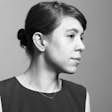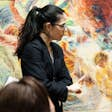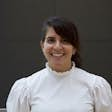Long term online programme: Modern and Contemporary Art and Design
Dates: any time
Duration: 7 months
Rating: 4.8 / 5.0 out of 12346 ratings (see top rating courses here)
Participating countries: any country
Organizer: The Museum of Modern Art at Coursera
Cost:
- FREE
- $49 with sharable certificate
Modern and Contemporary Art and Design
Through original films and audio, you will go behind the scenes to look closely at artworks and into studios to hear directly from artists, designers, curators and others. This Specialization is for anyone who would like to learn more about modern and contemporary art. No prior knowledge is required. Enroll to receive invitations to virtual events, gain exclusive access to MoMA resources, and share ideas with an international learner community.
Start with Modern Art & Ideas to learn how artists have taken inspiration from their environment and responded to social issues over the past 150 years. Next, take a deep dive into Seeing Through Photographs, exploring photography from its origins in the mid-1800s through the present. This course addresses the gap between seeing and truly understanding photographs by introducing ideas, approaches and technologies that inform their making.
Explore artworks made since 1980 in What Is Contemporary Art? Ranging from 3-D–printed glass and fiber sculptures to performances in a factory, the works in this course introduce you to the diverse materials, motivations and methods of artists working today. Complete the Specialization with Fashion as Design, and investigate the choices you make about fashion in relation to expression, sustainability, labor practices, identity and more. Learn from makers working with clothing every day—and, in some cases, reinventing it for the future.
Through original films and audio, you will go behind the scenes to look closely at artworks and into studios to hear directly from artists, designers, curators, and others. Enroll to receive invitations to virtual events, gain exclusive access to MoMA resources, and share ideas with an international learner community.
What you will learn
-
Develop a deeper understanding of artists’ and designers’ processes, including modes of experimentation and responses to technological innovation.
-
Develop critical thinking and looking skills to understand how artists and designers respond to the social and cultural issues of their time.
-
Gain confidence in looking at and talking about modern and contemporary art and design, and find inspiration from art all around you.
-
Better comprehend the choices you make about fashion with respect to expression, identity, and issues such as labor practices and sustainability.
Instructors

Sophie Cavoulacos
Assistant Curator
Department of Film

Sean Anderson
Associate Curator
Department of Architecture & Design
Arièle Dionne-Krosnick
Curatorial Assistant

Erica Papernik-Shimizu
Associate Curator
Department of Media & Performance

Christian Rattemeyer
Harvey S. Shipley Miller Associate Curator
Department of Drawings & Prints

Sarah Meister
Curator
Department of Photography

Lisa Mazzola
Assistant Director, School and Teacher Programs
Department of Education

Paola Antonelli
Senior Curator, Department of Architecture & Design, and Director, Department of Research & Development
Department of Architecture & Design

Michelle Millar Fisher
Curatorial Assistant
Department of Architecture and Design

Stephanie Kramer
Research Assistant
Department of Architecture & Design
Anna Burckhardt
Curatorial Assistant
Department of Architecture & Design
Programme
- Modern Art & Ideas: This course is designed for anyone interested in learning more about modern and contemporary art. Over the next five weeks, you will look at art through a variety of themes: Places & Spaces, Art & Identity, Transforming Everyday Objects, and Art & Society. Each week kicks off with a video that connects works of art from The Museum of Modern Art’s collection to the theme. You will hear audio interviews with artists, designers, and curators and learn more about selected works in the additional readings and resources.
Throughout this course you will discover how artists: — represent place and take inspiration from their environment, — create works of art to express, explore, and question identity, — use everyday objects to challenge assumptions about what constitutes a work of art and how it should be made, — and respond to the social, cultural, and political issues of their time through works of art. Through the discussion forum prompts and peer review assignment, you will also have the opportunity to connect with other learners and explore how these themes resonate with your own life and experience.
- Seeing Through Photographs: Taking, sharing, and viewing photographs has become second nature for many of us. Given our near-constant engagement with images this course will help you dig into the meaning of pictures and reconsider photography’s role in our visual culture. This course aims to address the gap between seeing and truly understanding photographs by introducing a diversity of ideas, approaches, and technologies that inform their making.
In this course you will look closely at 100 photographs from the collection of The Museum of Modern Art, going behind the scenes of the Museum and into artist studios through original films and audio interviews. You will hear a variety of perspectives on the ways photography has been used throughout its 180-year history: as a means of artistic expression, a tool for science and exploration, an instrument of documentation, a way to tell stories and record histories, and a mode of communication and critique. Short texts and readings from MoMA publications provide enhanced context for the works in the course. By enrolling in this course, you’ll join a community of international learners in discussion forums, receive invitations to live and virtual events from our lead instructor Sarah Meister, and gain exclusive access to MoMA resources. UPDATE: We’ve been listening to your feedback! In September 2020, we launched new content in Seeing Through Photographs, including audio interviews with additional contemporary artists from around the world, videos of Sarah introducing key ideas, and almost doubling the number of photographs from the collection. We’ve also added opportunities for you to share and receive feedback on your photographs in the discussion forums.
- What is contemporary art? In this course, you’ll consider this question through more than 70 works of art made between 1980 and the present, with a focus on art from the past decade. You’ll hear directly from artists, architects, and designers from around the globe about their creative processes, materials, and inspiration.
Five themes serve as your guide: Media from Television to the Internet, Territories & Transit, Materials & Making, Agency, and Power. You’ll look at 3-D–printed glass and fiber sculptures, performances in a factory and a museum, painted portraits—as well as those made with artificial intelligence—and interventions into television and video games. And much more, all drawn from the collection of The Museum of Modern Art. Come along as artists invite us into their studios, out into their neighborhoods, and to experiment with the materials they use. Not only will you develop a deeper understanding of how artists work today, you’ll also explore some of their many approaches to the pressing issues and questions of our time. By taking this course, you’ll gain confidence to look at contemporary art wherever you encounter it and make connections to your own life or creative practice.
- Fashion as Design: Among all objects of design, our clothes are the most universal and intimate. Like other kinds of design, fashion thrives on productive tensions between form and function, automation and craftsmanship, standardization and customization, universality and self-expression, and pragmatism and utopian vision. It exists in the service of others, and it can have profound consequences—social, political, cultural, economic, and environmental.
Fashion as Design focuses on a selection of more than 70 garments and accessories from around the world, ranging from kente cloth to jeans to 3D-printed dresses. Through these garments, we’re going to look closely at what we wear, why we wear it, how it’s made, and what it means. You’ll hear directly from a range of designers, makers, historians, and others working with clothing every day—and, in some cases, reinventing it for the future. Studio visits, interviews, and other resources introduce the history and development of each garment and their changing uses, meanings, and impact over time. Course Learning Objectives: Develop critical tools to appreciate and contextualize fashion design—from everyday clothing to couture garments—through many different perspectives. Trace the history, development, and impact of garments over time, and explore how they may be reinvented. Investigate garments through multiple lenses including politics, identity, and economics. Understand more about the lifecycle of clothing, from its design and production to its marketing, distribution, and consumption. Better comprehend the choices you make about fashion with respect to the visual language of dress, individual and collective identities, and issues such as labor practices, sustainability, and body politics.
Leave a Reply